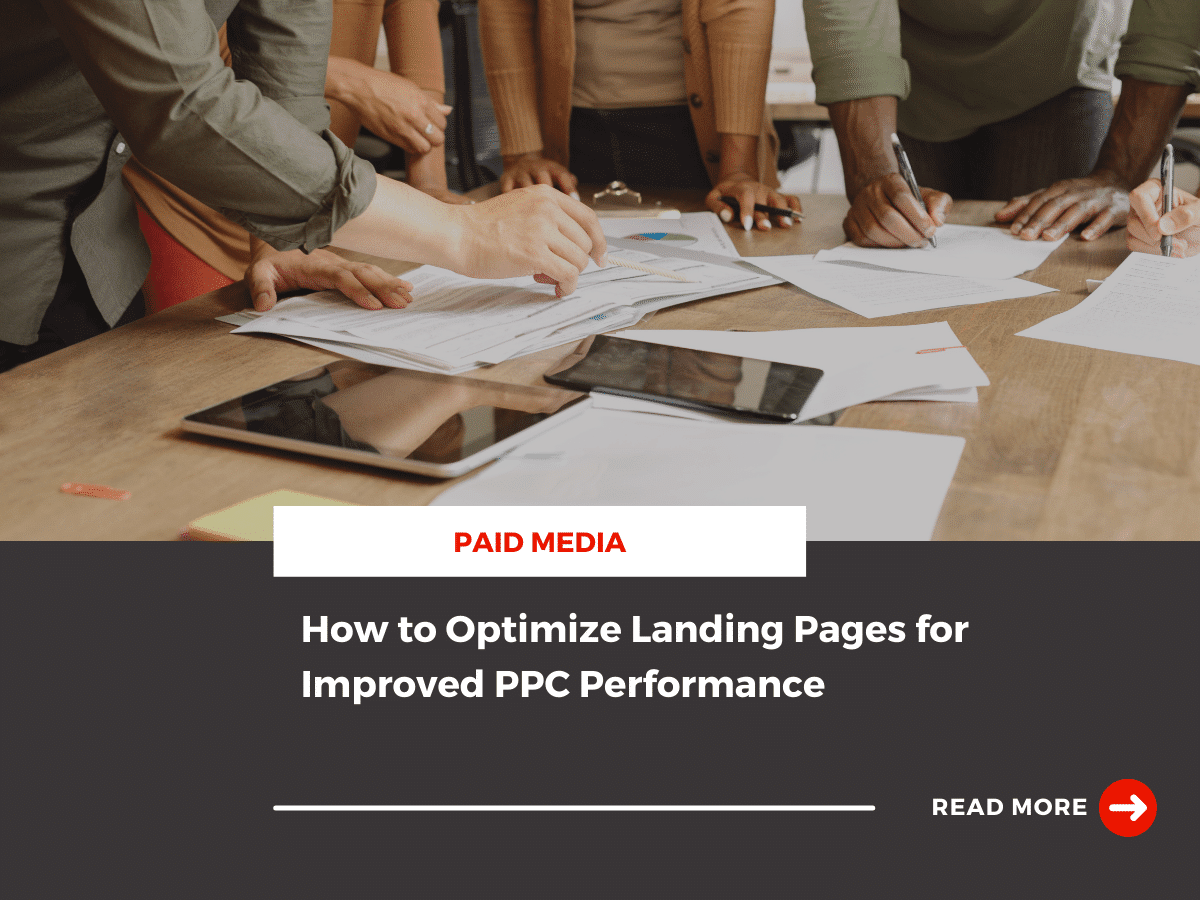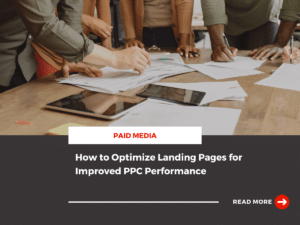Landing pages are an invaluable tool that helps your brand convert prospects into paying customers. They provide opportunities to increase conversions and get more eyes on your brand’s products and services. When paired with your PPC advertising strategy, you can create an experience that aims to answer your customer’s questions and drive more conversions over time.
However, you can’t just tie your PPC ads with your homepage or any old landing page. You’ll need to create a well-thought-out landing page that is strategic and purposeful. The fonts, images, colors, and CTAs you choose to include must be intentional and serve a purpose for the user experience.
When you take the time to craft a landing page that speaks to your audience’s needs, you can push more prospects through the sales funnel, increase conversions, and develop a PPC strategy that delivers results.
Here’s what you need to know about landing page optimization.
Start With Your Goals
A landing page needs to serve a purpose. Are you looking for customers to sign up for a free trial or book a demo with a sales rep? Are you selling tickets to an event or trying to gain more awareness about your newest product launch? Maybe, you’re a subscription-based business looking to target a niche audience with a specific offering.
No matter the purpose, it should always be the determining factor for all the other elements you choose to include on your landing page and the targeting parameters you put in place for your PPC advertising. Your purpose will also help you structure your landing page’s value proposition to align with your marketing goals.
Consider The Layout
When leading website visitors from your PPC ads to your landing page, you only have one opportunity to make a good impression. To push individuals through the sales funnel efficiently, you’ll need a layout that speaks to your customer’s needs and answers their questions in real-time.
Here are the main elements you’ll want to focus on:
- Purpose-Driven Headline: Your headline should be clear, concise, and aligned with your value proposition.
- Compelling Visual Design: Images, videos, and design elements should be purposeful and speak to your offering.
- Limit Layout Navigation: If customers need to scroll to the bottom of the page to find the CTA of your offering – it will impact your conversations. Try to limit the navigation and keep all the information in one place.
- Keep the Form Above the Fold: If you’re pushing customers to fill out a form, you’ll want the form to live above the fold. This will help increase conversions and won’t disrupt the user experience.
Include a Clear Call-To-Action
Once a customer lands on your landing page, there needs to be a call to action that drives consumers to take that next step. Whether it’s booking a demo, ordering now, or scheduling a consultation – these CTAs push web visitors through the sales funnel and encourage individuals to take action.
When adding CTAs to your website, there are a few things you’ll want to consider:
- Language: What words can you use that align with your goals that will push individuals to take action?
- Placement: A CTA should be clear, concise, and visible on the landing page. It should come after your offering messaging and shouldn’t be hidden, too small, or too big.
- Color: Choose eye-catching colors like red, green, or yellow
Include Social Proof
Reviews, user-generated content, and testimonials are types of social proof you can use to establish credibility and build trust with your audience. Adding social proof to your landing page is a great way to grab your audience’s attention at the moment and help persuade them to take action on your site. Here are some ideas for social proof you can include:
- Celebrity or influencer endorsements
- User-generated content
- Reviews or referrals
- Testimonials
- Social media posts
A/B Testing
A great way to know if your CTAs, copy, or layout is working is to A/B test your landing pages. This will help you optimize your approach to PPC performance and help you make data-driven decisions that align with your target audience’s needs.
To successfully A/B test your landing page performance, you’ll want to slightly adjust the elements you include on the landing page but keep the same target audience. This will help you understand what components resonate with your audience and drive the most conversions.
Here are some of the elements you can consider testing with your A/B test:
- Call-to-action (CTA) language and placement: Experiment with different variations of CTAs, such as different wording, button colors, or positions on the page. Assess which variations generate the highest click-through and conversion rates.
- Copy: Test different versions of your landing page copy, including headlines, subheadings, and body text. Vary the tone, messaging, and length of the copy to determine which version resonates best with your audience and leads to increased engagement.
- Images, graphics, and video content: Evaluate the impact of visual elements on your landing page. Test different images, graphics, or videos to determine which ones capture attention, convey your message effectively, and drive higher conversions.
- Colors, fonts, or layouts: Explore different combinations of colors, fonts, or layouts to see how they influence user behavior. Test variations to identify the visual elements that enhance readability, visual appeal, and overall user experience.
Improve Page Load Speed
When someone clicks on your PPC ads, they don’t want to wait for your landing page to load. A slow load speed can impact the user experience and push individuals away from your brand.
Here are a few quick ways to increase page load speed:
- Optimize image sizes: Compress and resize images to reduce file size without compromising quality.
- Minimize HTTP requests: Reduce the number of elements on your page, such as scripts, stylesheets, and images, to streamline loading.
- Leverage browser caching: Enable caching to store certain elements locally on the user’s device for faster subsequent visits.
- Minify code: Remove unnecessary spaces, comments, and line breaks from HTML, CSS, and JavaScript files to reduce their size.
- Use a content delivery network (CDN): Distribute static content across multiple servers worldwide for faster delivery.
If you’re still struggling with page load speed, it may be a sign of a bigger problem with your domain. Consider reaching out to an SEO agency for advice and tips on how to successfully perform a full site audit to make bigger improvements.
Be Strategic With Your Visual Components
It’s no secret that the visual components are more eye-catching and memorable than the text. While these elements are beneficial to the user experience, you won’t want to go overboard with videos and images. This can negatively impact the page load speed and distract your customers from the CTAs on the page. When adding visual components, every element you choose to include should be purposeful.
Here are some tips for choosing visual elements to improve your landing page experience:
- Choose high-quality, clear images of products or customers. Opt for visually appealing images that accurately represent your offerings or showcase satisfied customers to build trust and credibility.
- Use social proof as visual components. Display testimonials, reviews, or ratings from satisfied customers to provide social proof and reinforce the value of your products or services.
- Include informative or complementary videos. Incorporate how-to videos or videos that demonstrate your offering in action to provide valuable information and engage visitors.
- Add a high-quality and engaging hero image. Select a visually striking image that reflects your brand and immediately captures the attention of your visitors, effectively conveying the value proposition of your offerings.
FAQs about Landing Page Optimization
What is landing page optimization?
Landing page optimization is the process of optimizing your landing pages to improve the user experience and increase conversions. This process requires marketers to take a closer look at every element used on the landing page.
One of the best methods for testing what works and doesn’t work is A/B testing.
A/B testing provides invaluable insight into what is and isn’t working, so you can successfully optimize your landing page to meet the needs of your target audience.
What is the difference between SEO and PPC landing pages?
SEO landing pages are optimized for SEO purposes, and PPC landing pages are optimized for the paid ads you have running that connect with that landing page.
SEO landing pages are designed for search engines. This means you’ll want to optimize metadata, keywords, and on-site SEO elements to help you rank higher on the search engine results page. With PPC landing pages, your landing pages will already show up at the top of the SERPS, so instead, you’ll want to focus on making the user experience align with your PPC advertising goals and messaging.
What are the key elements of a high-converting landing page?
High-converting landing pages have three things: A call-to-action, consistent messaging, and a high-performing layout. When all of the elements on the landing page align with your offering or proposition, you can convert more prospecting into paying customers over time.
How can I use A/B testing to determine which elements of my landing page are most effective at driving conversions?
When A/B tests landing pages, you’ll want to focus on the key elements that drive conversions. You can A/B test your landing pages by changing your CTAs, images, copy, or layout to see which elements produce higher conversions.
To effectively A/B test, you’ll want to keep your targeting the same for your PPC and make adjustments to the landing pages. This will help you understand your customer’s behaviors and whether or aren’t working.
Increase Conversions With Kanbar Digital
PPC optimization strategies are an integral part of any effective marketing strategy. To scale your business, you must find innovative ways to improve your overall PPC performance and landing page experience for your target audience.
At Kanbar Digital, we can help you identify challenges and opportunities to help you get closer to the conversion rate you’re looking for. Over the years, we have worked with countless businesses in a variety of industries, helping them improve their landing page experience and enhance their PPC optimization strategies.




